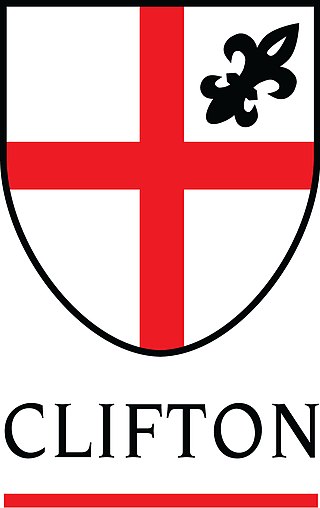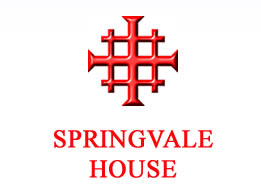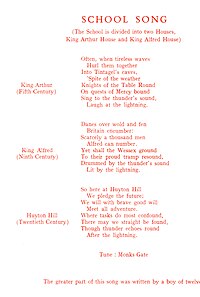Orley Farm School is one of the largest coeducational preparatory day school in the London borough of Harrow, at the foot of Harrow Hill on South Hill Avenue. It was founded as the preparatory school for the nearby Harrow School in 1850 but is now a fully private school in its own right and leavers continue to other private schools. The school grounds cover over 39 acres (160,000 m2).
The Downs Malvern is a private prep school in the United Kingdom, founded in 1900. It is located on a 55-acre (22 ha) site in Colwall in the County of Herefordshire, on the western slopes of the Malvern Hills. The school takes children aged 2 to 13 and comprises a nursery, kindergarten, pre-prep, and preparatory school; the preparatory school takes both day students and boarders. The Headmaster since 2009 has been Alastair Cook, who is a member of the Boarding Schools Association and the IAPS. Fees are currently up to £21,471 pa for full boarders and up to £16,221 pa for day pupils.

Dean Close School is a Public school for pupils aged 3–18) in Cheltenham, Gloucestershire, South West England, UK. The school is divided into pre-prep, preparatory and senior schools located on separate but adjacent sites outside Cheltenham town centre, occupying the largest private land area in the town at 50 acres. The school is now co-educational, with both day and boarding pupils, who may be enrolled as young as 3 in the pre-preparatory school, and continue through to 18 at the senior school. Dean Close is a member of the Headmasters' and Headmistresses' Conference.
Huyton College was an independent day and boarding school for girls founded in England in 1894 as the sister school to Liverpool College with which it merged on 27 July 1993, a few months short of its 100th birthday. The Liverpool College for Girls, Huyton, as it was originally known, was started in 1894 and intended to be parallel to the Liverpool College Boys' Upper School. It catered for girls between the ages of 4 and 18. In its early days, and towards the end of its time based at Huyton Hall before the merger, it also took day boys up to the age of seven. The school is mentioned in the book The Wildcats of St Trinian's by Frank Launder.
Marlborough House School is a co-educational preparatory school situated in 34 acres (14 ha) of countryside in Hawkhurst, Kent. The school currently has just over 260 pupils between the ages of 2.5 and 13 with a teaching staff of 60. Marlborough House is predominantly a day school, but operates a flexi-boarding policy for pupils over the age of eight. The school is a member of the Independent Association of Preparatory Schools (IAPS).

Clifton School (Durban) is an independent day school for boys in Durban, KwaZulu-Natal, South Africa.
Liverpool College is a school in Mossley Hill, Liverpool, England. It was one of the thirteen founding members of the Headmasters' Conference.
The Elms School is a co-educational private boarding prep school located in Colwall, Herefordshire, England. Including the Early Years and Pre-Prep departments, it caters for children from 3 to 13 years old. The Headmaster from April 2023 is Mr Ed Lyddon, who is a member of the Boarding Schools Association and the Independent Association of Prep Schools (IAPS); The Elms was one of the IAPS's founding schools.

St Faith's School is a private preparatory day school on Trumpington Road, Cambridge, England, for girls and boys aged four to thirteen. The headmaster is Crispin Hyde-Dunn, and the school has in excess of five hundred children. St Faith's is part of The Leys and St Faith's Schools Foundation. It is named after the French martyr St Faith.

Priory Preparatory School was a preparatory school in Banstead, Surrey, England, for boys aged two to thirteen years, which was closed in 2017. The school was a member of the Independent Association of Preparatory Schools (IAPS) and of the Independent Schools Council (ISC). It was founded in 1921, and was a charitable trust. Upon closure in 2017, pupils moved to the new Banstead Preparatory School at the site formerly occupied by Greenacre School for Girls. The school's buildings at the old site on Bolters Lane, including the historic mansion known as the Red House were demolished in January 2021 to make way for the development of retirement apartments.

Christ Church Cathedral School is an independent preparatory school for boys in Oxford, England. It is one of three choral foundation schools in the city and educates choristers of Christ Church Cathedral, and the Chapels of Worcester College and Pembroke College. It is a member of the IAPS and the Choir Schools Association.
Wellington School was a small private school in Wellington Road, Bebington, Metropolitan Borough of Wirral, England.

Kingsmead School was a co-educational private day school for boys and girls aged 2 to 16 and, from 2018 until its closure, offered a sixth form for students up to age 18. The school is located in Hoylake, on the Wirral Peninsula. The school was founded in 1904 by Arthur Watts, a Baptist minister and mathematician. In 1911 the school motto was selected, "Dominus Vitae Robur" – The Lord is the Strength of my Life. Kingsmead is a member of the Independent Association of Preparatory Schools (IAPS).
Aberlour House is the junior school of Gordonstoun School, and is now fully merged with it. It educated pupils from age 6 to 13.
The Independent Association of Prep Schools is a schools association, representing around 670 preparatory schools.
Lagos Preparatory & Secondary School (LPSS) is a private co-educational day school in the affluent Ikoyi suburb of Lagos, Nigeria, and has adopted the UK National Curriculum; it was established in 2002. LPSS which was formerly known as LPS, provides Early Years, Primary and Secondary school education for children from 18 months up to age 16+.

The Eaton House Group of Schools is a group of private schools, all situated in London. It is composed of the Eaton House the Manor Nursery, Eaton House the Manor Pre-Preparatory, Eaton House the Manor Preparatory, Eaton House the Manor Girls' School, Eaton House Belgravia Pre-Preparatory, and Eaton House Belgravia Preparatory. The group became a limited liability company, with Sovereign Capital becoming the majority shareholder, when principal Hilary Harper retired and sold the company in 2016. The schools are non-selective at ages 3 and 4. In June 2021, Eaton House Schools became part of the Dukes Education group of schools.

Springvale House Preparatory School is an independent, preparatory, boarding and day school in Mashonaland East, Zimbabwe that was established in 1952. The school shares facilities with Peterhouse Girls' School on the Springvale Estate of approximately 1,200 acres (490 ha) with Gosho Park, a conservation area on the estate, being adjacent to the two schools. The majority of the pupil population are boarders while the remainder are day scholars.

Sompting Abbotts Preparatory School is a historic West Sussex independent school in Sompting, near Worthing and Steyning. It educates children of both sexes aged 2 to 13. The school sits in parkland of 30 acres, which includes woodland, chalk grassland slopes and a pond.

Orwell Park School is a day and boarding preparatory school for boys and girls in the village of Nacton on the edge of Ipswich in the English county of Suffolk. Founded in 1868 in Lowestoft, the school currently accommodates around 300 boys and girls between the ages of 2½ and 13 years. It is a member of the IAPS.











